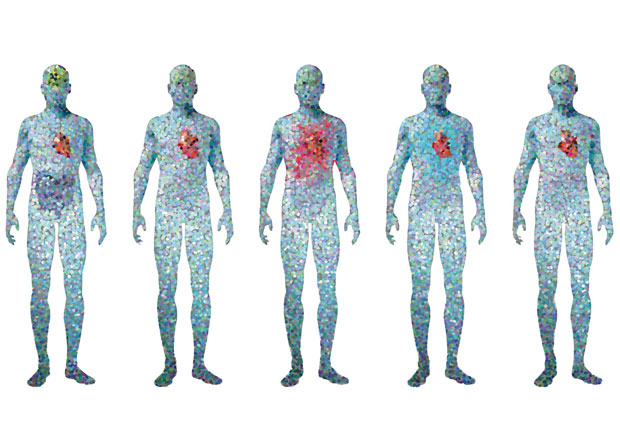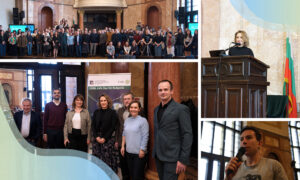LifeTime – a visionary proposal for an EU Flagship
Reliably predicting the onset and trajectory of a disease might seem like a distant dream. But a European consortium is aiming to achieve exactly this using a set of emerging technologies with the analysis of single cells at their core. Leading scientists have now submitted the proposal for a FET Flagship called LifeTime.

Following the completion of the Human Genome Project in 2001, scientists and the media described the genome as “the book of life”, holding the answers to the way genes are linked to disease. Yet, seventeen years later, we are still deciphering how cells interpret this book.
Since then, so-called Omics technologies have flourished, allowing researchers, for example, to observe and quantify thousands of gene products in a single tissue sample. Omics experiments used to require tens of thousands of cells. But in the last couple of years, novel single-cell methods have emerged which enable scientists to perform such global analyses in individual cells. The molecular make-up of tissues and organs can now be assessed at single-cell resolution.
Snapshots are not enough
Mapping and analyzing tissues at the single-cell level is highly informative and challenging by itself, but a diverse group of 60 scientists across Europe decided that merely taking snapshots is not enough. Cells are highly dynamic entities and may even change identities. To understand molecular forces behind different cell states in development, aging and disease, these scientists want to track the molecular make-up of human cells in time and space. To this end, they formed the LifeTime consortium with the goal of establishing an integrated toolbox containing several novel revolutionary methods.
Single-cell technologies will be applied to experimental model systems such as organoids, miniature organs grown in the petri dish from one or more cells. Combined with the genome editing tool CRISPR/Cas as well as state-of-the-art microscopy, these models will help to understand how cells stay healthy or progress towards disease and react to therapeutics. Importantly, LifeTime scientists will also develop computational strategies such as powerful machine-learning and artificial intelligence methods that help to understand molecular mechanisms and predict the future of a patient’s tissue or even means to steer the tissue towards health. This strategy is expected to improve early diagnoses and intervention, predict the course of a disease, identify new drug targets and select the most effective therapies for individual patients.
A group of pioneers
Future and Emerging Technologies Flagships (such as the ongoing Human Brain Project, the Graphene and the Quantum Technologies Flagship) are funded by the European Commission with one billion Euros for ten years. The competition for the next two Flagships has just started, and proposals have been submitted. LifeTime – jointly coordinated by the Max Delbrück Center for Molecular Medicine in the Helmholtz Association (MDC) in Berlin and the Institut Curie in Paris – is one of them.
Currently the LifeTime consortium consists of over 60 leading single-cell biologists, computer scientists, mathematicians, clinicians, pathologists, imaging experts, and physicists from over 50 European institutions in 18 countries. They are pioneers in their disciplines, working towards a common vision of future medicine, and would like LifeTime to be an open endeavor that will attract new talents and integrate all scientists in Europe who can make a significant contribution. Their unique collective network will transcend institutional boundaries and improve the overall infrastructure for the life sciences in Europe, with a focus on training for the next generation of scientists.
Steer life sciences and healthcare to the future
The LifeTime consortium will build on the achievements of the Human Cell Atlas (HCA), an international project launched about a year ago. The HCA aims to create a map of healthy tissues with single-cell technologies, thereby capturing the enormous diversity of cell types within those tissues. LifeTime proposes to go far beyond providing static tissue maps and to track, understand and predict how the molecular make-up of cells changes during human diseases and ultimately intervene.
It is a vision that can steer both life sciences and healthcare into the future and kick-start a single-cell innovation ecosystem in Europe. Many technologies at the center of LifeTime are key European research strengths that the Flagship could boost. These include single-cell technologies combined with advanced imaging, artificial intelligence and patient-matched organoids, or organ-on-a-chip disease models to study the progression of an illness and develop novel therapeutics.
Inspiration from Renaissance Europe
As an inspiration, LifeTime scientists name Renaissance Europe. Back then, new types of telescopes permitted Brahe, Galileo and Kepler to accurately map the precise positions of stars and planets. They were able to decode the patterns in these maps thanks to new types of mathematics developed by Leibniz and Newton, and thus discovered that celestial bodies moved in rule-governed and therefore predictable ways. Their efforts reshaped the society of their time.
Similarly, emerging technologies now allow scientists to observe cells (corresponding to planets in this analogy) and entire organs (corresponding to solar systems) with unprecedented precision. New mathematical and computational tools will be required to understand the movement and relationships of those cells. The resulting ability to explain cellular changes as they age or progress towards disease will fundamentally change our perception of how organisms function and will greatly advance medicine.
The LifeTime consortium
The more than 60 scientists and clinicians forming the LifeTime consortium are distributed over 18 European countries and 52 institutions. Both the Helmholtz Association of German Research Centres and the French National Center for Scientific Research CNRS – two of the biggest science organizations in Europe – have pledged their strong support. Furthermore, the consortium is endorsed by Science Academies such as the German National Academy of Sciences Leopoldina, the French Academy of Sciences, the Royal Society and the Royal Netherlands Academy of Sciences and Arts and the EU-life Alliance. Professor Nikolaus Rajewsky, Director of the Berlin Institute for Medical Systems Biology at the Max Delbrück Center for Molecular Medicine, and Professor Geneviève Almouzni, CNRS senior researcher and director of the research center at Institut Curie in Paris, are jointly coordinating the LifeTime proposal.
Participating institutions
Helmholtz Association • CNRS • Institute of Molecular Biotechnology • Research Center for Molecular Medicine of the Austrian Academy of Sciences • VIB-KU Leuven • Friedrich Miescher Institute for Biomedical Research • University of Basel • University of Zurich • Central European Institute of Technology • Max Planck Institute of Immunobiology and Epigenetics • Max Planck Institute for Molecular Genetics • German Cancer Research Center • Max Delbrück Center for Molecular Medicine • German Center for Neurodegenerative Diseases • Helmholtz Zentrum München • Max Planck Institute for Evolutionary Anthropology • Helmholtz Institute of RNA-based Infection Research • Saarland University • Technical University Munich • University of Würzburg • Biotech Research & Innovation Centre • Interdisciplinary Nanoscience Center • University of Copenhagen • Centre for Genomic Regulation • Institut Curie • Université de Montpellier • Inserm • Université Toulouse III – Paul Sabatier • École nationale supérieure des mines de Paris • Institute for Molecular Medicine Finland • The Biomedical Research Foundation, Academy of Athens • Weizmann Institute of Science • Hebrew University • Sapienza – University of Rome • Instituto Nazionale Genetica Molecolare • University of Napoli • University of Padua • University of Milan • European Institute of Oncology • Netherlands Cancer Institute • Radboud University • University Medical Center Utrecht • Hubrecht Institute • Instituto Gulbenkian de Ciência • Institute of Bioorganic Chemistry of the Polish Academy of Sciences • Romanian Center for Systems Immunology • Karolinska Institute • MRC Human Genetics Unit • University of Edinburgh • Wellcome Sanger Institute • The Babraham Institute • European Molecular Biology Laboratory – European Bioinformatics Institute



